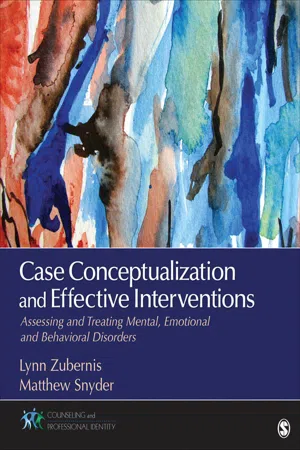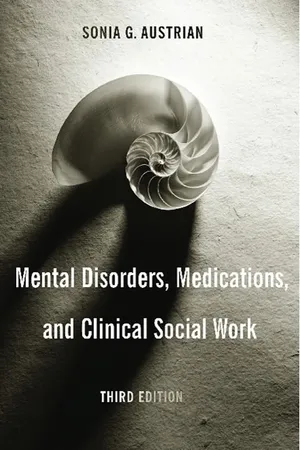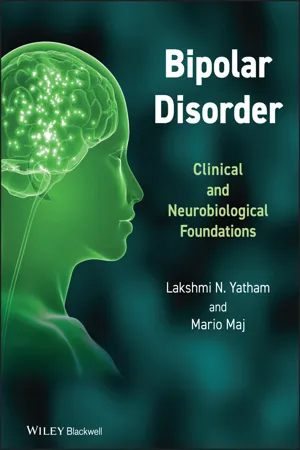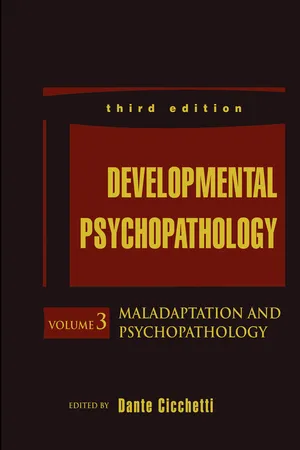Psychology
Bipolar Disorder
Bipolar disorder is a mental health condition characterized by extreme mood swings that include emotional highs (mania or hypomania) and lows (depression). These mood shifts can be disruptive to daily life and can affect energy levels, judgment, behavior, and the ability to think clearly. Treatment typically involves a combination of medication and psychotherapy to manage symptoms and improve quality of life.
Written by Perlego with AI-assistance
Related key terms
7 Key excerpts on "Bipolar Disorder"
- Michael B. First, Allan Tasman(Authors)
- 2011(Publication Date)
- Wiley(Publisher)
CHAPTER 28 Mood Disorders: Bipolar Disorder DiagnosisMood episodes are discrete periods of altered feeling, thought, and behavior. Typically they have a distinct onset and offset, beginning over days or weeks and eventually ending gradually after several weeks or months. The definition of Bipolar Disorder is built on the identification of individual mood episodes (Table 28.1 ). Bipolar Disorder is defined by the occurrence of depressive plus manic, hypomanic, or mixed episodes, or the occurrence of only manic or mixed episodes.Table 28-1 Summary of mood episodes and mood disordersEpisode Disorder Major Depressive Episode Major Depressive Disorder, Single Episode Major Depressive Episode + Major Depressive Episode Major Depressive Disorder, Recurrent Major Depressive Episode + Manic/Mixed Episode Bipolar I Disorder Manic/Mixed Episode Bipolar I Disorder Major Depressive Episode + Hypomanic Episode Bipolar II Disorder Chronic subsyndromal depression Dysthymic Disorder Chronic fluctuations between subsyndromal depression and hypomania Cyclothymic Disorder Most individuals with a Bipolar Disorder have major depressive as well as mania or hypomanic episodes. Those who experience manic episodes are diagnosed with Bipolar I Disorder, and those with major depressive and hypomanic (milder manic) episodes are diagnosed with Bipolar II Disorder. This separation of Bipolar II Disorder from both Bipolar I Disorder and Major Depressive Disorder is supported by several types of evidence. For instance, Bipolar II Disorder occurs more frequently in families of persons with Bipolar II Disorder in comparison to families of persons with Bipolar I Disorder or Major Depressive Disorder. Study of the course over time of Bipolar II Disorder indicated that persons with hypomania tended to have recurrent hypomanic episodes and did not convert into Bipolar I Disorder by developing mania. In addition, persons with Bipolar II Disorder may have more episodes over time than persons with Bipolar I Disorder. However, biological differences between these bipolar types have not been reliably demonstrated.- eBook - ePub
Case Conceptualization and Effective Interventions
Assessing and Treating Mental, Emotional, and Behavioral Disorders
- Lynn D. S. Zubernis, Matthew J. Snyder(Authors)
- 2015(Publication Date)
- SAGE Publications, Inc(Publisher)
Betsy, Dorothy, and Chuck are all suffering from a Bipolar Disorder. Bipolar Disorder is not only one of the most difficult mental health issues to treat, but also one of the most stigmatized and misunderstood. Formerly included with the other Depressive Disorders, the DSM-5 created a separate category for Bipolar and Related Disorders in order to facilitate correct diagnosis and understanding. Unlike the depressive disorders, Bipolar Disorders include episodes of both depression and the opposite “pole,” mania or hypomania.Most of us know what depression is. In some ways, mania is considered the opposite—a state of intense elation or irritability. The disorders are referred to as “bipolar” because most people who experience a manic episode also experience a depressive episode. When in a manic state, individuals do not think or behave in the same way as they usually do. Often they speak more loudly and more quickly, jumping from subject to subject, known as “pressured speech.” It is difficult to interrupt their stream of conversation, which has been described as a “flight of ideas.” Social judgment may also be impaired, with people missing the social cues that ordinarily tell us when another person doesn’t welcome a particular interaction. Some individuals engage in sexual relationships that they otherwise would not, or in other reckless behavior, such as spending large amounts of money or driving too fast. During a manic episode, people tend to sleep less, but feel more energetic and there may be increased motor activity. There may be grandiose thinking and heightened self-esteem, with individuals convinced they can accomplish great things, but there is also often the tendency toward angry outbursts and episodes of rage. Manic episodes tend to begin abruptly over a one or two day time period.Bipolar Disorders are differentiated by the duration and severity of the manic symptoms. Bipolar I disorder is diagnosed if there is at least one manic episode during the individual’s lifetime. Bipolar II is diagnosed if the individual meets criteria for hypomania (but not mania) for at least four days and a major depressive episode. Hypomania is similar to mania, but less extreme. The individual in a hypomanic state is more grounded in reality and thinking more clearly, although there is a change in normal functioning. People may be more sociable, may engage in flirtatious behavior, and may feel energetic and productive. The client may feel euphoric, but behavior does not have the driven quality of a manic episode. These changes must be observable to others, but unlike a manic episode, these changes in behavior are less likely to cause significant disruption to everyday activities. Consider the three clients we met in the beginning of this chapter. Dorothy is experiencing a hypomanic episode, while Betsy is in the midst of a manic episode, and Chuck is experiencing a depressive episode after having been through several manic episodes. - Sonia Austrian(Author)
- 2005(Publication Date)
- Columbia University Press(Publisher)
Bipolar Disorder and major depression represent the extremes, and cyclothymia and dysthymia fall between them. Major depression has a lifetime prevalence of 17 percent and is the most common mental disorder. Although current diagnostic thinking uses duration of episodes as a criterion, it would appear that mood disorders actually exist on a continuum. For example, many people with cyclothymia are vulnerable for episodes of mania and major depression, and many diagnosed with dysthymia experience major depression. Even though major depression is the most common mental disorder, mood disorders are the most undertreated of all mental disorders.Depression is second only to coronary heart disease in the number of days people spend in the hospital or disabled at home. It is estimated that the annual cost is $11.7 billion in days lost at work, $12.1 billion in decreased productivity, and $7.5 billion in costs for psychiatric intervention, including medication, psychotherapy, and hospitalization.Definitions
Bipolar Disorder is also known as manic-depressive disorder. This disorder is frequently marked by periods of inconsolable sadness and despair (major depression) alternating or intermixed with periods of extreme cheerfulness, energy, extravagance, and talkativeness that may suddenly turn into rage and hostility (mania). Usually the presence of one of the moods is followed by a period of the opposite mood. DSM-IV-TR divides Bipolar Disorder into bipolar I, which is manifested by major depressive and manic episodes, and bipolar II, which is characterized by major depressive and hypomanic episodes (American Psychiatric Association 2000)Cyclothymia is a term derived from the Greek meaning “cyclic mood.” It is a milder, more chronic form of Bipolar Disorder; an individual is not free of symptoms for more than two months in a period of at least two years. The mood swings are less extreme: the manic phase is termed hypomania, and the depressed phase is less severe than a major depression.Major depressive disorder (unipolar)- eBook - ePub
- Deborah C. Beidel, B. Christopher Frueh(Authors)
- 2018(Publication Date)
- Wiley(Publisher)
Chapter 7 Bipolar and Related Disorders Sheri L. Johnson and David J. MiklowitzOver the past two decades, there has been a considerable resurgence of interest in Bipolar Disorder (BD; formerly known as manic-depressive illness). This resurgence is attributable in part to the availability of new data on pharmacological agents and psychological treatments for the disorder, as well as a growing body of work on the genetic, neurophysiological and neuroanatomical contributors. It has also been driven by the increasing recognition that the onset of the disorder is often in childhood or adolescence.In this chapter, we describe diagnostic criteria, epidemiology, and course and prognosis of BD, with particular attention to developmental considerations pertinent to early-onset bipolar illness. Although few studies have examined psychosocial factors relevant to the onset of BD, there is now a considerable literature on psychosocial stressors that affect the course and outcome of the disease and we consider these psychosocial factors as we review the course and prognosis of BD. We then discuss the pharmacological and psychological approaches to treatment of BD. We describe current diagnostic debates and considerations, and we summarize available diagnostic tools. A case study then illustrates diagnosis and treatment. Current etiological models view BD as a primarily genetic illness that creates a biological vulnerability to symptoms. Although the nature of biological vulnerability remains unclear, biological vulnerability is assumed to intensify the individual's vulnerability to environmental stressors. In the final sections, we offer directions for further research.Description of the Disorder
Several forms of BD have been recognized. All are defined by manic symptoms of varying degrees of severity and duration. The core symptoms believed to constitute mania—elation, grandiosity, and hyperactivation—have been recognized for well over 100 years and remain fairly consistent across editions of the Diagnostic and Statistical Manual of Mental Disorders (DSM). In this section, we describe the core features of mania, hypomania and depression according to DSM-5 - eBook - ePub
Psychopathology and Psychotherapy
DSM-5 Diagnosis, Case Conceptualization, and Treatment
- Len Sperry, Jon Carlson, Jill Duba Sauerheber, Jon Sperry(Authors)
- 2014(Publication Date)
- Routledge(Publisher)
5 Depression and Bipolar DisordersPaul R. Rasmussen and Dinko AleksandrofThe Diagnostic and Statistical Manual of Mental Disorders , published by the American Psychiatric Association, is considered to provide the official nomenclature for diagnosis and research. Since its introduction in 1952, it has undergone numerous changes and seen several different editions. Most recently, the American Psychiatric Association introduced its latest version—DSM-5 (American Psychiatric Association, 2013), which intended to advance clinical practice and empirical research by further improving the diagnostic criteria for mental disorders.During its evolution as a psychological theory, the school of Individual Psychology (IP) has sought ways to incorporate the nomenclature system of the DSM into its conceptual framework. Aside from the numerous works published in the literature, the Journal of Individual Psychology devoted a special issue in 2002 to the connection between the DSM and Individual Psychology. As Maniacci (2002) notes, the five axes of the DSM system largely resemble the biopsychosocial and holistic perspectives espoused by Individual Psychology.The current chapter will provide an overview of the changes in DSM-5 for the depressive and Bipolar Disorders. It will also introduce the reader to the way Adlerian theorists might conceptualize depression, mania, and related conditions. In doing so, the chapter will offer a way of integrating the DSM nomenclature system into the theory of Individual Psychology, particularly its understanding of psychopathology. The disorders covered in this chapter include Major Depressive Disorder, episodic and recurrent; Disruptive Mood Dysregulation Disorder; Persistent Depressive Disorder (Dysthymic Disorder); Bipolar I Disorder; Bipolar II Disorder; and Cyclothymic Disorder.An Adlerian View
Several factors contribute to the expression of “problems in living” and to DSM-based clinical conditions, which may or may not be different. While some conditions are more medical, implying a physical pathology in need of medical intervention, more often psychological/emotional problems emerge as a consequence of one’s inability to adequately overcome life challenges. This model emphasizes a “psychology of use” perspective rather than a “psychology of possession” view. In this perspective it is understood that symptoms emerge because they are useful to the individual; they may not be optimally useful, but they help to resolve or overcome an immediate - eBook - ePub
Bipolar Disorder
Clinical and Neurobiological Foundations
- Lakshmi N. Yatham, Mario Maj(Authors)
- 2011(Publication Date)
- Wiley(Publisher)
et al. [35], of 1380 STEP-BD bipolar patients with depressive episodes, found that two-thirds of this sample had concurrent manic symptoms, most often distractibility, flight of ideas, or racing thoughts and psycho-motor agitation. Patients with mixed features were more likely to have an early age of onset, rapid cycling in the past year, suicide attempts and more days in the preceeding year with irritability or mood elevation. The authors conclude that manic symptoms often accompany bipolar depression, but are often overlooked when they appear less prominent than depressive features and subsyndromal manic symptoms during bipolar I or II depression demarcate a more common, severe and complex clinical state than pure bipolar depression.Schizoaffective disorderThe diagnosis of schizo-affective disorder is a contentious problem shared by the Mood Disorders Workgroup and the Psychosis Workgroup. While in its current form it has turned out to have rather low reliability, it has been found by Tohen et al. to be the most commonly used second diagnosis in a group of patients initially diagnosed as psychosis NOS. Currently, it seems that the Psychosis Workgroup is recommending that it be dropped and diagnosed by using the diagnosis of schizophrenia with a behavioural dimension of mania or depression. Because schizoaffective disorder is one of the most frequently used diagnoses, at this point it has been decided that the diagnosis will be retained in DSM-V changes in the wording of the criteria which will hopefully increase the reliability of this diagnosis. The psychosis Workgroup has currently proposed to retaine the diagnosis because of the frequency of its use, with changes in the diagnostic criteria aimed at making the diagnosis more reliable than it currently is.Paediatric Bipolar DisorderThe issue of diagnosing Bipolar Disorder in children is also a major issue. Bipolar Disorder has a serious prognosis and often requires treatment with powerful medications that may have serious side effects and in some cases long-term medical risks, so when relying on symptom presentations and history as contrasted with laboratory tests, having the most effective diagnostic criteria is of great concern. It appears that irritability, although certainly common in Bipolar Disorder at all ages, is quite a promiscuous symptom across a range of diagnoses and may not be very useful in discriminating Bipolar Disorder from other disorders. Separating Bipolar Disorder from ADHD and Oppositional Defiant Disorder in children is a concern [55]. A recent study of 637 youths with a 10 item scale demonstrated good discrimination between Bipolar Disorder and attention deficit disorder, and showed that parents most notice elated mood, high energy, irritability and rapid changes in mood and energy as the prominent features of juvenile Bipolar Disorder [56,64]. The question has been raised whether children with Bipolar Disorder manifest shorter (as short as four hours) episodes occurring frequently over periods such as four days. This would suggest the possibility of different criteria for paediatric Bipolar Disorder than those currently in place for adults. On the other hand, there are obvious concerns for overdiagnosis as there must be a balance of overdiagnosis versus Underdiagnosis of paediatric Bipolar Disorder. A field test of criteria and further discussions with the Developmental/Lifespan Issues Task Force Committee will be required to decide this issue. - Dante Cicchetti(Author)
- 2016(Publication Date)
- Wiley(Publisher)
Virtually all of the symptoms of Bipolar Disorder may be evident early in the life span, long before a formal diagnosis of the disorder is made. There is considerable evidence that depression, and to a lesser degree, hypomania is a common precursor of Bipolar Disorder in adults (e.g., Baldessarini, Tondo, & Visioli, 2014). One retrospective study found that subthreshold manic and depressive symptoms characterizing the prodrome were present for an average of 10 months prior to the onset of adolescent bipolar I disorder (Correll et al., 2014). A chart review of child and adolescent medical records was conducted on bipolar adults (Scott-Gurnell et al., 2014). As children, these adult patients generally manifested a range of symptoms that resembled forms of hypomania or mania. However, elevated mood was not typically part of the presentation; rather, anxiety and irritability were more prominent. Despite the similarity of symptoms, only 23% had been diagnosed with Bipolar Disorder in childhood. Some of these differences may be attributed to developmental trajectories associated with different types of Bipolar Disorder (Baldessarini, Tondo, & Visioli, 2014). That is, patients with bipolar II were most likely to present initially with depression (77%) while patients with bipolar I were likely to present initially with depression (46%) as well as psychosis or mania (13 to 22%).There is growing evidence that both homotypic and heterotypic continuity are evident in Bipolar Disorder (Rutter, Kim-Cohen & Maughan, 2006). Over the past decade, Duffy and her colleagues have continued to revise a model in which Bipolar Disorder is shown to evolve through a series of phenotypically different clinical stages for Bipolar Disorder in adolescence (Duffy, 2010, 2013). These authors proposed a clinical staging model of Bipolar Disorder, suggesting that the early natural history of Bipolar Disorder unfolds in a series of predictable clinical stages. In Duffy's (2010) first model, in childhood there was a progression from asymptomatic (well) status to the nonmood disorders (e.g., significant anxiety, sleep, or neurocognitive disturbances such as attention deficit disorder, learning disorders, distortions in reality testing). In adolescence, these problems resulted in minor or major mood disturbances, depression, and eventually mania. Additionally, substance abuse was evident during or after the mood disturbances. Subsequently, these authors have focused more extensively on the role of early anxiety in this developmental progression (Duffy et al., 2013). Most recently, they proposed that offspring of lithium responders are more likely to show the earlier identified progression, in contrast to the offspring of lithium nonresponders who were more likely to have a more varied early course characterized by neurocognitive disturbances and develop psychotic disorders (Duffy et al., 2014). Klimes-Dougan and colleagues have recently elaborated on key factors of this model that more centrally implicate disturbances in reality testing and other indexes of neurocognitive disturbances. For instance, they have documented differences in thought problems and neurocognitive deficits in offspring of bipolar and unipolar parents (Klimes-Dougan et al., 2006, 2013; Narayan, Allen, Cullen, & Klimes-Dougan, 2013) and evaluated thought problems as precursors of Bipolar Disorder and other psychotic problems (Klimes-Dougan et al, 2013; Meyer et al., 2004).
Learn about this page
Index pages curate the most relevant extracts from our library of academic textbooks. They’ve been created using an in-house natural language model (NLM), each adding context and meaning to key research topics.






